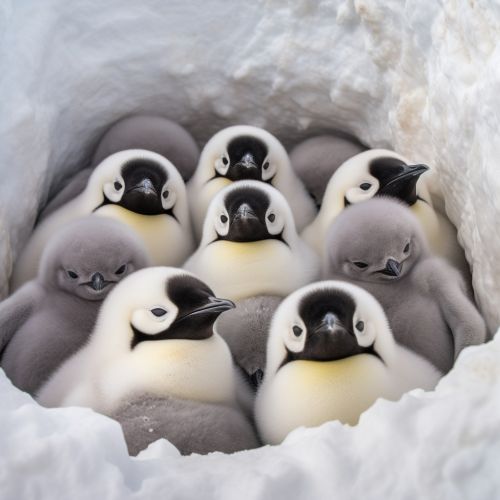Antarctic Wildlife
Introduction
Antarctic wildlife refers to the variety of animal species inhabiting the Antarctic region, a harsh and extreme environment characterized by frigid temperatures, strong winds, and a landscape predominantly covered by ice and snow. This wildlife is adapted to survive in such extreme conditions and includes a diverse array of species, from microscopic organisms to large mammals.
Adaptations to the Antarctic Environment
Antarctic wildlife has evolved a range of unique adaptations to survive in the harsh Antarctic environment. These adaptations include physical, physiological, and behavioral traits that enable these species to thrive in conditions that would be inhospitable to most other forms of life.
Physical Adaptations


Many Antarctic species have developed physical adaptations to cope with the cold. For instance, the Emperor penguin has a layer of insulating feathers and a thick layer of blubber to retain body heat. Similarly, the Weddell seal, one of the few mammals found in Antarctica, has a thick layer of blubber that serves as both insulation and a source of energy when food is scarce.
Physiological Adaptations
Physiological adaptations are also common among Antarctic wildlife. For example, the Antarctic krill, a key species in the Antarctic food chain, can reduce its metabolic rate and enter a state of dormancy during the long Antarctic winter when food resources are limited.
Behavioral Adaptations
Behavioral adaptations are crucial for survival in the Antarctic. Many species, such as the Emperor penguin and the Antarctic fur seal, engage in social behaviors that help them conserve heat and survive the harsh winters. For instance, Emperor penguins huddle together in large groups to share body heat during the coldest months.
Biodiversity in Antarctica
Despite the harsh conditions, Antarctica is home to a surprisingly diverse array of wildlife. This biodiversity is largely concentrated in the Southern Ocean and along the Antarctic Peninsula, where conditions are relatively milder.
Marine Life
The Southern Ocean is teeming with marine life, including several species of whales, seals, and penguins, as well as a variety of fish and invertebrates. The blue whale, the largest animal on Earth, is a frequent visitor to Antarctic waters during the summer months.
Terrestrial Life
Terrestrial life in Antarctica is limited due to the extreme cold and lack of vegetation. However, a few species of birds, such as the snow petrel and the South Polar skua, nest on the Antarctic mainland. Additionally, several species of insects and arachnids, including the Antarctic midge and the Antarctic springtail, can be found in the few ice-free areas of the continent.
Microbial Life
Microbial life forms, including bacteria, algae, and fungi, are the most abundant and diverse organisms in Antarctica. These microorganisms play a crucial role in the Antarctic ecosystem, contributing to nutrient cycling and primary production.
Threats to Antarctic Wildlife
Antarctic wildlife faces a number of threats, primarily from human activities. These include climate change, overfishing, pollution, and the introduction of non-native species.
Climate Change
Climate change is perhaps the most significant threat to Antarctic wildlife. Rising temperatures are causing the Antarctic ice to melt, which can lead to loss of habitat for species that depend on the ice for survival, such as the Emperor penguin and the Weddell seal.
Overfishing
Overfishing is another major threat, particularly for species that rely on krill, such as whales, seals, and penguins. The krill fishery in the Southern Ocean is one of the largest in the world, and overfishing can deplete krill populations, disrupting the Antarctic food web.
Pollution
Pollution, particularly from plastic waste and oil spills, can have devastating effects on Antarctic wildlife. Many marine animals, such as seals and penguins, can become entangled in plastic waste or ingest it, leading to injury or death.
Introduction of Non-native Species
The introduction of non-native species, either intentionally or accidentally, can disrupt the delicate balance of the Antarctic ecosystem. Non-native species can outcompete native species for resources, leading to declines in native populations.
Conservation Efforts
A number of measures have been implemented to protect Antarctic wildlife. These include the establishment of protected areas, restrictions on fishing, and regulations to prevent pollution and the introduction of non-native species.
Protected Areas
Several protected areas have been established in Antarctica to preserve its unique wildlife. These include the South Orkney Islands Southern Shelf Marine Protected Area, which protects a diverse array of marine life, including whales, seals, and penguins.
Fishing Restrictions
Fishing in the Southern Ocean is regulated by the Commission for the Conservation of Antarctic Marine Living Resources (CCAMLR). The CCAMLR sets catch limits for different species to prevent overfishing and ensure the sustainability of the Antarctic ecosystem.
Pollution and Non-native Species Regulations
The Antarctic Treaty System includes measures to prevent pollution and the introduction of non-native species. These include regulations on waste disposal and the cleaning of equipment to prevent the accidental introduction of non-native species.
